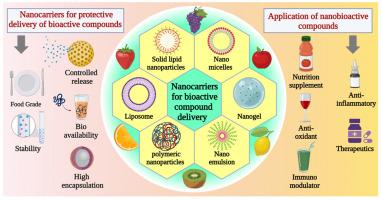Emerging biopolymer nanocarriers for controlled and protective delivery of food bioactive compounds- current status and future perspective
IF 11
1区 农林科学
Q1 CHEMISTRY, APPLIED
引用次数: 0
Abstract
Nanotechnology offers various nanostructures that can enhance the bioavailability and solubility of bioactive food ingredients. Among these, nanocarriers play a significant role in the delivery of bioactive food compounds. Biopolymers are commonly used to fabricate nanocarriers, enabling encapsulation, protection, and controlled release of nutraceuticals. This review explores the use of nanocarriers, particularly biopolymer-based ones, for the delivery of bioactive food compounds. Gum-based, alginate-based, and plant protein-based nanocarriers have been discussed, highlighting their ability to deliver compounds to targeted sites, enhance bioavailability, and mitigate side effects. In addition, the development of nutraceutical delivery systems has been examined to provide insights for future applications. The review also delves into the advancements in photoactive nanocarriers, emphasizing their reliability and minimally invasive nature for the on-demand delivery of active payloads. This review elucidates the effects and advantages of various biopolymer-based carriers for encapsulating, protecting, and delivering bioactive compounds. Emerging nanocarriers offer controlled and protective delivery of food-derived bioactive compounds, addressing the need for efficient nutraceutical delivery systems. Overall, this review comprehensively discusses different types of emerging nanocarriers and their applications in the controlled and protective delivery of food-derived bioactive compounds. This highlights the promising prospects of utilizing nanotechnology to enhance the efficacy and safety of nutraceuticals, paving the way for innovative solutions in the food and medical industries.

用于控制和保护性输送食品生物活性化合物的新兴生物聚合物纳米载体--现状与未来展望
纳米技术提供的各种纳米结构可以提高生物活性食品成分的生物利用度和溶解度。其中,纳米载体在输送生物活性食品化合物方面发挥着重要作用。生物聚合物通常用于制造纳米载体,从而实现营养保健品的封装、保护和控释。本综述探讨了纳米载体,特别是基于生物聚合物的纳米载体在输送生物活性食品化合物方面的应用。讨论了以胶为基础、以藻酸盐为基础和以植物蛋白为基础的纳米载体,强调了它们将化合物输送到目标部位、提高生物利用率和减轻副作用的能力。此外,还研究了营养保健品递送系统的发展,为未来的应用提供了见解。该综述还深入探讨了光活性纳米载体的发展,强调了其按需递送活性有效载荷的可靠性和微创性。本综述阐明了各种基于生物聚合物的载体在封装、保护和递送生物活性化合物方面的效果和优势。新出现的纳米载体可控制和保护食品生物活性化合物的输送,满足了对高效营养保健品输送系统的需求。总之,本综述全面讨论了不同类型的新兴纳米载体及其在控制和保护性递送食品生物活性化合物方面的应用。这凸显了利用纳米技术提高营养保健品功效和安全性的广阔前景,为食品和医疗行业的创新解决方案铺平了道路。
本文章由计算机程序翻译,如有差异,请以英文原文为准。
求助全文
约1分钟内获得全文
求助全文
来源期刊

Food Hydrocolloids
工程技术-食品科技
CiteScore
19.90
自引率
14.00%
发文量
871
审稿时长
37 days
期刊介绍:
Food Hydrocolloids publishes original and innovative research focused on the characterization, functional properties, and applications of hydrocolloid materials used in food products. These hydrocolloids, defined as polysaccharides and proteins of commercial importance, are added to control aspects such as texture, stability, rheology, and sensory properties. The research's primary emphasis should be on the hydrocolloids themselves, with thorough descriptions of their source, nature, and physicochemical characteristics. Manuscripts are expected to clearly outline specific aims and objectives, include a fundamental discussion of research findings at the molecular level, and address the significance of the results. Studies on hydrocolloids in complex formulations should concentrate on their overall properties and mechanisms of action, while simple formulation development studies may not be considered for publication.
The main areas of interest are:
-Chemical and physicochemical characterisation
Thermal properties including glass transitions and conformational changes-
Rheological properties including viscosity, viscoelastic properties and gelation behaviour-
The influence on organoleptic properties-
Interfacial properties including stabilisation of dispersions, emulsions and foams-
Film forming properties with application to edible films and active packaging-
Encapsulation and controlled release of active compounds-
The influence on health including their role as dietary fibre-
Manipulation of hydrocolloid structure and functionality through chemical, biochemical and physical processes-
New hydrocolloids and hydrocolloid sources of commercial potential.
The Journal also publishes Review articles that provide an overview of the latest developments in topics of specific interest to researchers in this field of activity.
 求助内容:
求助内容: 应助结果提醒方式:
应助结果提醒方式:


